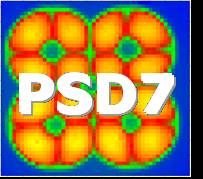Speaker
Dr
Alexander Rodin
(Flerov Laboratory of Nuclear Reactions, Russia)
Description
We present an array of position sensitive detectors designed for the
work with the beam of radioactive nuclei delivered by the separator
ACCULINNA /1/. It is in use in the studies made on the structures of
light nuclei with extreme neutron excess /2/. A pair multi wire
proportional chambers (MWPC) installed in the front of a target is
used for the measurement of the hit co-ordinates and inclination
angles of the trajectories of individual beam nuclei entering the
target. An annular type EEE charged particle telescope, intended
for reaction products, makes another part of the detector array.
Each MWPC has two planes of mutually perpendicular wires. Each plane
is made by 32 20 µm Ta(Au) wires wound with a 1 mm step. These
chambers can deal with a maximum beam intensity approaching 5105
pps. The two chambers working together provide for a 95 % detection
efficiency for the beam nuclei of 6He and 8He. The telescope
involves three annular silicon detectors and a circular array of CsI
(Tl) crystals matching the geometry the Si detectors. The front Si
detector involves eight separate 40 µm thick Si modules assembled to
make a detector ring with inner and outer diameters of 26 and 70 mm,
respectively. A 300 µm thick annular Si detector with an active area
having the inner and outer diameters of 32 and 85 mm, respectively,
just follows after the front detector in the telescope. This double-
side strip detector has 32 unbroken rings, on one side, and 64
sector strips on another side. The third, 1000 µm thick Si detector
is similar in its active area with the second one, but it has only
one set of 64 strips. The CsI(Tl) array is composed of sixteen 19 mm
thick trapeziform modules in a way allowing one to cover with its
sensitive area a ring having inner and outer diameters of 33 and 88
mm, respectively. The read out of the light coming from the CsI(Tl)
crystals is provided by spectrometric photodiodes. The energy
resolution is characterized by 50 and 150 keV full widths at half
maximum obtained for 5.5 MeV α peaks, respectively, with the 300 and
1000 µm Si detectors and with the CsI(Tl) crystals. By means of this
telescope one can well detect and identify nuclei with atomic
numbers from Z=1 to Z=6 having energy in a range from 1.5 to 70 MeV.
The whole system works well in experiments where the hitting
position of individual ions on the target is defined with a
precision of ±0.75 mm and the emission angles of reaction products
are fixed within ±1.5 mrad. Beam tests showed an overall energy
resolution of 0.7 % obtained for 130 MeV 6He nuclei.
References
1. Rodin A.M., Stepantsov S.V., Bogdanov D.D. at. al. Nucl.
Inst. and Meth. in Physics Research B 204 (2003) 114-118.
2. Golovkov M.S., Grigorenko L.V., Fomichev A.S. et. al., Phys.
Rev. Lett., 93 (2004) 262501.
Primary author
Dr
Alexander Rodin
(Flerov Laboratory of Nuclear Reactions, Russia)
